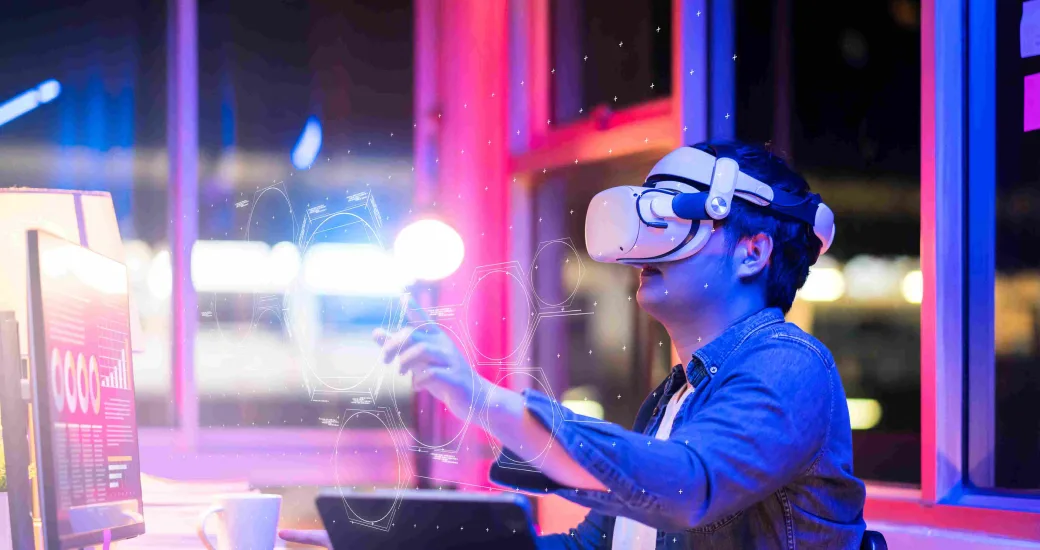Augmented reality technology has become a lasting presence, reshaping how we engage with the world around us. Introducing digitally crafted elements into our real-life surroundings through smart devices can revolutionize various sectors, including education, healthcare, entertainment, and gaming.
For those who want to understand the importance of Augmented reality. We've compiled a guide covering the basics of augmented reality, its applications, and the top 5 tools for developing augmented reality experiences. If you're considering venturing into this industry, you must grasp the fundamentals to navigate the landscape effectively. Explore the Augmented reality development services and open up new possibilities for your projects.
What is Augmented Reality and its application?
Augmented reality (AR) is a technology that overlays computer-generated images onto a user's real-world view, creating a blended experience. AR serves various purposes, enhancing users' perceptions of their surroundings or delivering extra information and entertainment. Augmented reality customer services can increase your engagement and user satisfaction.
Augmented Reality has a wide range of applications in different domains:
Entertainment: Remarkable successes like Pokemon Go showcase AR's potential in gaming. It also elevates the experience in movies, TV shows, and live events.
Education: AR brings learning to life, enabling students to explore the human body or virtually tour historical sites, making lessons more engaging.
Business: Boosting productivity, AR aids workers by overlaying instructions or information directly onto real-world objects.
Retail: AR assists customers in visualizing products in their own spaces or virtually trying on clothing.
Navigation: Providing directions and information about nearby points of interest, AR enhances navigation experiences.
Healthcare: AR contributes to improved surgical procedures, offers patients insights into their conditions, and aids rehabilitation efforts.
Types of Augmented Reality Apps
Augmented reality applications offer various experiences, enhancing customer interactions in unique ways. Some solutions focus on recognizing graphic markers, such as QR codes or complex graphs. Others utilize data from GPS, and a few combine both features. One example of emerging technologies in this space is full-body motion tracking AR and VR solutions. These are particularly beneficial for industries seeking realistic interactions within virtual environments.
1. Full-Body Tracking Solutions: Manus VR pioneers advanced full-body tracking for AR and VR. The Polygon system and Prime II gloves create hyper-realistic virtual interactions, benefiting industries like automotive, manufacturing, and entertainment for collaborative experiences.
2. Marker-Based Apps: These apps recognize markers, like QR codes, overlaying virtual elements onto the real world. While resource-intensive, they ensure precise tracking, contributing to enhanced customer experiences across different sectors.
3. GPS Data-Focused Apps: Some AR applications use GPS data to offer location-specific augmented experiences, enhancing customer engagement with relevant, location-based content.
4. Gyroscope-Based Apps:Leveraging smartphone gyroscopes, these apps bring virtual elements to life in the user's environment, providing an engaging customer experience through natural movements.
5. SLAM Apps (Simultaneous Localization and Mapping):SLAM-based AR apps revolutionize the landscape by creating three-dimensional objects within the real world, offering dynamic and markerless experiences for more fluid customer interactions.
5 Best Augmented Reality Tools to Consider
Before discussing the 5 Augmented reality tools, let’s discuss SDK. An SDK, short for Software Developer Kit, is a type of augmented reality software. It's a collection of programs and software utilized in creating other software. The key benefit of SDKs lies in their ability to enable developers to apply established solutions and shortcuts in development. This avoids addressing every generic problem individually, saving time and effort. Constructing simulations is complex, and having the right tools helps work efficiently.
Let's explore five popular tools for Augmented Reality creation -
1. Vuforia
Vuforia is a top AR tool in the augmented reality software development kits list, developed by Qualcomm, a company initially recognized for its contributions to wireless communication and electronic microchips. Vuforia offers several products, including Vuforia Engine, Studio, and Chalk.
What sets Vuforia apart is its support for marker-based and markerless AR applications, excelling in object recognition and 3D modeling. Its standout features include Ground Plane, facilitating content addition to horizontal surfaces, Visual Camera for expanded visual source support beyond mobile phones and tablets, and VuMarks, enabling custom markers for Vuforia face recognition and data encoding.
Vuforia also includes the QCAR library written in C++, housing various targets such as image cubes, cuboids, cylinders, word targets, and frame markers. With functionalities like Extended Tracking for object persistence beyond the frame(once the object is captured, it remains captured even if it leaves the frame) and Smart Terrain.
Supported platforms include Android, iOS, Universal Windows Platform, and Unity Editor, ensuring a broad reach for applications developed using Vuforia. While a free version is available, it has limitations, making it suitable for hobbyists. For more advanced features and commercial use, Vuforia offers subscription plans, including Classic ($499 one-time), Cloud ($99 monthly), and Pro, with individually tailored pricing for commercial applications.
2. ARToolKit
ARToolKit stands out as an open-source tool, and it is available on different platforms, including Android, iOS, Windows, Linux, and OS X. Originated in 1999, since then, ARToolkit has evolved and developed various updates such as planar image tracking, black square recognition, and real-time speed support. With its roots tied to DAQRI, this SDK has gained popularity and has loads of tutorials on platforms like YouTube, making it accessible for beginners and seasoned developers.
ARToolKit's approach involves processing real-time graphic data captured by a mobile camera guided by square object markers. This process results in the display of augmented objects on the smartphone screen, considering their location in space. Beyond its user-friendly appeal, ARToolKit has other capabilities, including support for 2D and 3D image processing, OpenGL specification support in collaboration with GLUT libraries, camera position, orientation tracking, and efficient marker identification using a simple black square.As the demand for augmented reality development services grows, ARToolKit is a reliable choice, offering a freeware solution.
3. Unity 3d
Unity is a favored platform among game developers and creative minds, known for its robust capabilities in providing AR experiences. With a wealth of AR-related assets and plugins, Unity simplifies the process of building engaging and interactive AR projects. Its user-friendly interface makes it accessible for developers. Unity is a versatile choice as it supports both iOS and Android development.
4. Wikitude
Wikitude is an excellent option for those delving into AR software development. Despite being established in 2008, it has gained a solid reputation, sparking active discussions in the debate between Vuforia and Wikitude. This platform supports the development of apps for iOS, Android, and Smart Glasses devices, offering tracking methods and technologies and giving competition to other augmented reality development programs. Wikitude has additional features like geolocation, cloud recognition, and distance-based scaling.
Developers find Wikitude flexible, allowing them to smoothly create and customize solutions and integrate third-party tools. Still, one has to write a JS code using Wikitude JS SDK. Creating augmented reality objects is simplified through an online studio, where users upload images, add AR elements, generate JS code, and seamlessly integrate it into their projects. Wikitude presents various possibilities and is supported across major platforms, including Android, iOS, and Windows for tablets.
When working with Wikitude, developers can import and render 3D objects with SLAM technology, design apps for smart glasses, utilize cloud or on-device storage, leverage location-based services, and use various development frameworks like JavaScript API, Native API, Xamarin, Unity3D, Cordova, and Titanium. The inclusion of object, scene, and image recognition features, along with the user-friendly Wikitude Studio for managing virtual objects without coding, enhances the appeal of this AR development platform. Pricing options include a free trial with watermarks and paid subscription plans, starting from €1,990 per app.
5. ARCore
ARCore, developed by Google, stands as the Android counterpart to Apple's ARKit, indicating Google’s supporting AR app development for both Android and iOS platforms.
ARCore uses three fundamental technologies to blend virtual content into natural environments: motion tracking, environmental recognition, and lighting recognition. The SDK ensures that 3D models respond dynamically to changes in lighting volume, generating shades and maintaining stability despite smartphone movements. Utilizing a proprietary camera, ARCore accurately defines the parameters of physical objects and horizontal surfaces, automatically anchoring created things to tabletops, floors, and other environmental surfaces.
ARCore offers diverse functionalities and is supported across Android 7.0+, iOS 11+, Android NDK, Unity for Android, Unity for iOS, and Unreal Engine. ArCore SDK allows developers to track a phone's motion and position relative to surrounding objects, estimate and adapt to lighting conditions on virtual objects, detect surfaces, understand their size and location in the environment, and share texts or virtual objects with other app users. ARCore supports Java/OpenGL, Unreal, and Unity, allowing for the creation of 3D objects using Tilt Brush and Blocks VR building tools. This ArCore SDK is available for free.
Wrapping Up
Augmented reality tools are reshaping how we interact with the world through smart devices. The AR tools discussed in this blog offer unique features and capabilities. Vuforia, developed by Qualcomm, helps in object recognition and 3D modeling, while ARToolKit is an open-source solution that simplifies AR development. Unity 3D, favored by game developers, is user-friendly for iOS and Android. Although new, Wikitude is flexible, supporting features like geolocation and cloud recognition. Google's ARCore, for Android and iOS, smoothly integrates virtual content. Collectively, these tools empower developers to create immersive augmented reality experiences across various platforms.
Subscribe to Saffron Tech
Explore your marketing zen with our newsletter! Subscribe now.



